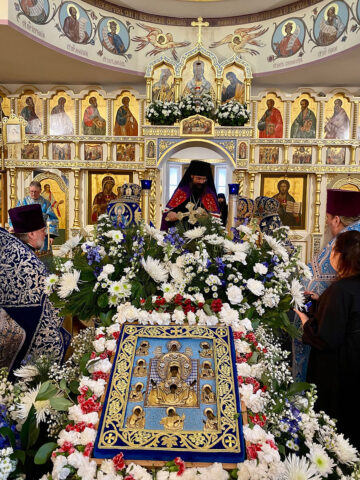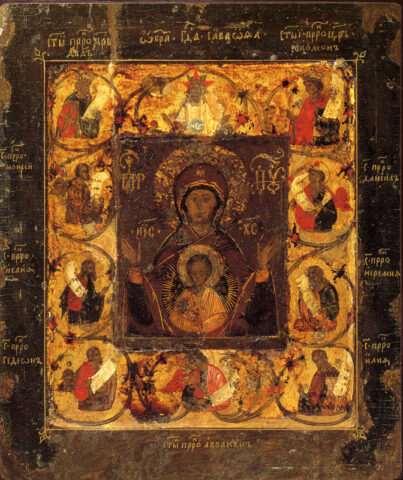Kursk Root Icon: A sacred relic to visit Gibraltar
By Daniel Brancato
Gibraltar is set to welcome a rare and historic visitor: the Kursk Root Icon of the Theotokos (‘Mother of God’) of The Sign, one of the Russian Orthodox Church’s most venerated miracle-working icons.
Making its first appearance here on November 1, 2025, this sacred artifact will be housed at the Cathedral of St Mary the Crowned. This event, drawing Orthodox faithful from the neighbouring region, marks a significant moment for our small community.
The icon will visit Gibraltar as part of a wider pastoral tour across Europe, organised by the Russian Orthodox Church Outside of Russia (ROCOR), which will see the revered relic travel to parishes across the continent.


SURVIVING TARTAR RAIDS
The icon’s story begins in 1295, during the Tatar invasions that devastated the Kursk region (in modern-day Russia). A hunter from Rylsk discovered it face down at the root of a tree along the Tuskar River on the feast of the Nativity of the Theotokos. As he lifted it, a spring of pure water burst forth — the first of many miracles. A chapel was soon built, drawing many pilgrims.
In 1383, the Tartars again ravaged Kursk. When they tried to burn the chapel, the flames would not catch. Enraged, they accused the priest, Bogoljub, of sorcery, cut the icon in two, and took him captive. In exile, the faithful priest prayed to the Theotokos until emissaries of Tsar Dmitry (later canonised as Saint Dmitry Donskoy) ransomed him. Returning home, he found the two halves of the icon - which miraculously rejoined in his hands, though the mark of the cut remained. The people built a new chapel on the site, where the icon stayed for nearly two centuries.
TSAR’S PROTECTION
In 1597, Tsar Feodor Ivanovich ordered the rebuilding of Kursk and requested that the icon be brought to Moscow, where it was received with great reverence. The Tsaritsa, Irene Theodorovna, adorned it with a riza - a precious metal covering designed to protect and embellish the icon while leaving the faces visible. With the Tsar’s support, a monastery was later founded on the site of its discovery, named the Kursk Root Hermitage after the spring and tree where the icon had first appeared. During an invasion of Crimean Tartars, the icon was transferred to the cathedral church of Kursk, and an exact copy was left at the Hermitage. Tsar Boris Godunov bestowed many precious gifts for the adornment of the icon.
SACRED TALISMAN IN TROUBLED TIMES
Over the following centuries, the icon was carried into battle and was credited with saving Kursk from siege in 1612. A copy of the icon was sent to General Kutuzov during Napoleon’s 1812 invasion of Russia.
HEALING A SAINT AND ARTISTIC LEGACY
The icon’s power is legendary.
In 1767, it healed a young Prokhor Moshnin, who was to become St. Seraphim of Sarov, during a rain-soaked procession. In 1898, revolutionaries bombed it in Kursk’s Znamensky Cathedral, shattering windows and marble but leaving the icon intact, enhancing its fame.
Its cultural impact endures in Ilya Repin’s 1883 painting Religious Procession in Kursk Governorate, held at the Tretyakov Gallery, depicting a vibrant yet socially divided procession.
REVOLUTION AND BEYOND
The 1917 Bolshevik Revolution brought new threats. The icon was stolen from the Cathedral of the Sign in Kursk on April 12, 1918. It was recovered in early May 1918, having been hidden in a well. Following the Bolshevik advance, the icon was moved to Novorossiysk in late 1919. On March 1, 1920, it was placed aboard the Saint Nicholas steamship under the protection of Bishop Theophan Bystrov, departing Russia for Thessaloniki, Greece. From there, it continued its journey to Serbia where it remained until WWII. During the war, the homes and churches the icon had visited in Belgrade remained unscathed despite bombings.
In 1944, it moved to Vienna and Munich, finally reaching the United States in 1951, where it is now under the custodianship of ROCOR at the Cathedral of Our Lady of The Sign in New York.
SCHEDULE
This visit, a bridge between past and present, invites all to witness a relic of enduring faith.
The Orthodox Community of Gibraltar extends its heartfelt gratitude to Bishop Carmel Zammit and Bishop-Elect Charles Azzopardi for their blessing in welcoming the icon to the cathedral. Their gesture of support and Christian solidarity has made this historic visit possible.
• Friday, October 31, 4:00 PM–6:00 PM: Akathist hymn, intercessory prayer, and confessions with a priest ahead of the icon’s arrival.
• Saturday, November 1, 10:30 AM–12:00 PM: Divine Liturgy of St. John Chrysostom. The icon will be present in the cathedral.









